Is Cuomo Serious About Addressing Climate Change? Indian Point Decision Says No

Indian Point (photo: the governor's office)
Governor Andrew Cuomo claims that New York is a leader in addressing the dangers of climate change. So far, the facts fail to support this.
Since 2010, New York’s gas-fired and dual-use (gas & oil) electric capacity has increased over four times as fast as wind plus other sources of renewable power. Fossil fuels today produce eight times as much electricity as all our renewables, exclusive of hydropower. This movement towards greater fossil fuel use is about to get far worse if the carbon-free Indian Point nuclear plant is shut down and replaced by natural gas.
The Climate Leadership and Community Protection Act (CLCPA), signed by the governor in July, commits New York to eliminate the burning of fossil fuels for electricity by 2040. Tragically, long before 2040, all the hoped-for benefits of the CLCPA will be negated. In just a few weeks, Unit 2 of the Indian Point nuclear power plant in Westchester is scheduled to shut down, to be replaced by gas-fired power that will release 3.5 million metric tons of carbon dioxide into the atmosphere each year.
Next year Unit 3 will shut down, adding a similar amount of greenhouse gases to the atmosphere each year thereafter. At that rate, the “world’s largest off-shore wind farm” that the governor hopes to build off of Long Island will not show any net environmental benefit for at least 20 years. We can’t wait that long to deal with climate change.
Further, in spite of CLCPA declarations and over the objections of many citizens, the Cuomo administration recently approved an increase in electric rates to enable Con Edison to expand its use of natural gas. Earlier, the state authorized the construction and operation of several new natural gas-burning plants, including a very large gas plant in Dutchess County due to open in May.
Most inexplicably and disastrously, the Cuomo administration has agreed to shut down the Indian Point plant in Westchester County. Its safe and reliable power is the largest clean source of electricity in the downstate region, providing fully 80% of our carbon-free power. Indian Point’s closure will set back New York’s climate plans for decades. What is going on here?
In many parts of the country, nuclear plants, the nation’s major source of carbon-free power, are threatened with closure by competition from lower-cost natural gas. Here in New York, nuclear power provides 32% of our electricity and over half our carbon-free energy (hydropower supplies most of the rest). The governor supports subsidizing upstate nuclear plants that provide clean energy, jobs, and tax revenue, but he has refused to provide similar support for the Indian Point plant, even though it supplies 25% of the Metro region’s electricity as well as many jobs and local tax revenue. It appears that he has been misled by fear-mongering false claims like the need for massive evacuations and other myths. The scientific community has debunked all these myths, but state leadership is unmoved.
When the governor announced the closure agreement, he told the people of New York that replacement power would add no new carbon to the atmosphere. This commitment will not be met if Indian Point is replaced by gas. Worse, present gas pipeline and power plant limitations may require that the dirtiest gas plants in New York City are pressed into service. Many of these polluting plants are located in low-income environmental justice areas. Pollutants that worsen asthma and other ailments will assail the residents of these communities.
Achieving a low-carbon future will require vast increases in clean electricity production, and all renewable sources are challenged. Hydropower cannot be expanded very much at all. Land-based wind power accounts for just 3% of the state’s electricity output today, and no new wind installations are currently under construction.
Even with the planned expansion of New York’s transmission system, only limited amounts of upstate wind power can be brought to the downstate region. The planned off-shore wind farm will just begin to bring some electricity to New York City by 2028, if it proceeds on schedule. However, this enormous project will have to be accompanied by giant banks of storage batteries if it is to supply reliable electricity to the Metro area when the wind isn’t blowing.
Solar energy provides just 1.6% of the state’s electric output today. The state government’s climate plan requires that solar energy produce more than 30% of our electric output by 2030, but at the current rate at which solar panels are being installed, this goal won’t be reached for 100 years. A recent comprehensive report from the Citizens Budget Commission, an influential think tank, found that the projected expansion of solar and wind was “likely infeasible.” It seems clear that the state lacks a workable plan to provide the growing amount of carbon-free electricity we will need to address the climate crisis.
Nuclear energy has shown, over the last 60 years, that it can provide large quantities of safe and reliable electric power. Its costs are high, but advanced designs and more efficient manufacturing methods can bring these down. These advanced designs are capable of producing electricity where and when it is needed.
As a start, there is no need to shut down Indian Point. This facility has been running safely and reliably for nearly 50 years, and it could keep going for many more. The governor’s closure agreement wisely allows Unit 2 to continue operating until 2024 and Unit 3 a year longer. Further, major issues have recently arisen with the decommissioning of these plants that will need more time to be sorted out. We should use this closure agreement to its fullest and extend operations four more years.
While the state develops a new, realistic energy plan using all its carbon-free resources, it should not shutter the Indian Point nuclear plant.
***
Leonard Rodberg is a physicist who taught climate change and public policy at Queens College/CUNY until his retirement in 2017. Herschel Specter is an engineer who focused on nuclear safety issues in many positions, including at the Nuclear Regulatory Commission and the International Atomic Energy Agency.
***
Have an op-ed idea or submission for Gotham Gazette? Email This email address is being protected from spambots. You need JavaScript enabled to view it.
Lessons for the New York Primary from Sanders’ Nevada Blowout
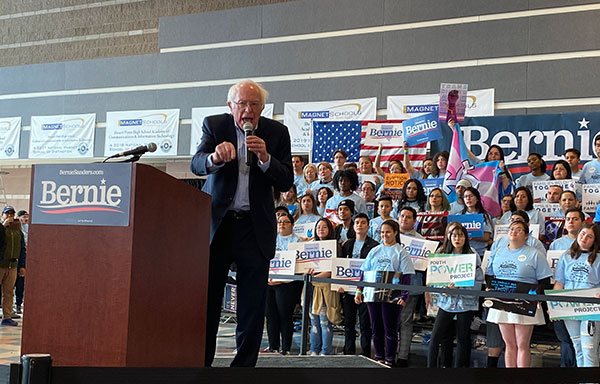
Bernie Sanders & Make the Road Action in Nevada (photo: Make The Road)
People across the country were stunned by Bernie Sanders’ 28-point victory in the Nevada caucuses. Not our members. Why? From Make the Road Action’s on-the-ground work mobilizing Latino voters and other voters of color in East Las Vegas, it was clear that the Sanders campaign had overwhelming support in our communities. The Latino vote was his secret weapon.
And looking forward, Sanders’ performance in Nevada, where 30% of the population is Latino, and people of color are the majority of the population, has important implications for future primaries closer to home -- like in New York, where 18% of the state’s population is Latino and people of color make up more than 40% of the population.
Over the past two months, our members in Las Vegas had a front-row seat to observe the Sanders campaign’s dominant ground game in Latino communities and other communities of color. The campaign prioritized hiring a diverse staff with deep community connections, and investing real resources—dollars and staff time, not lip service—into organizing these communities. While other campaigns relied primarily on the airwaves, the Sanders campaign, through a robust precinct-by-precinct outreach strategy and culturally-relevant event series like “Tamales con Tio Bernie,” showed a clear focus on in-person organizing.
The campaign also showed a deep commitment to grassroots partnerships and the synergies they bring. Since early last year, the Sanders campaign engaged community organizations like Make the Road Action and our members, asking for input on policy platforms and organizing strategy.
When our members ultimately chose to endorse Sanders, the campaign also worked to make us an integral part of the campaign. When Senator Sanders held a rally in Las Vegas on the first day of early voting, four of our members spoke first—sharing their experiences of fighting for affordable housing and against unjust immigration policies in Las Vegas. When we marched to an early caucus site right after, Sanders marched with us.
The campaign’s commitment to community partnership yielded concrete results. Our Nevada members were so energized that our team ultimately knocked on 10,000 doors and made more than 30,000 phone calls to engage Latino voters and other voters of color across East Las Vegas. We also reached millions of people nationwide via social media with original, bilingual content highlighting our support for Sanders.
On caucus day, we saw the fruits of that labor. Statewide, entrance polls showed Sanders winning a clear majority of Latino votes—a remarkable feat given that there were 11 names on the ballot. At the dozens of precincts across East Las Vegas that we covered, Sanders won overwhelmingly, with community members reporting to us that they had received visits at their doors from the campaign and from Make the Road Action. When one of our poll-site interpreters asked an older Latina voter for whom she was voting, she went into her purse, pulled out a Make the Road Action flyer, pointed to Sanders' face, and said: "I'm voting for him."
The Nevada results have clear implications for states like New York, with large Latino populations and many voters of color. Here, too, we can already see the strength of the Sanders ground game, with an all-volunteer statewide infrastructure collecting 65,000 petition signatures to get him on the New York ballot.
And, as in Nevada, our black and Latino members in New York, alongside progressive elected officials—like Alexandria Ocasio-Cortez, Jumaane Williams, Jessica Ramos, Julia Salazar, Ron Kim, Mike Gianaris, and others—and partner organizations like Democratic Socialists of America and New York Progressive Action are already energized and organizing for the April primary.
Those efforts have begun to bear fruit, with a new Siena poll this week showing Sanders in the lead in the Empire State for the first time in this contest, and with a solid lead among Latino voters.
With the strongest organizing infrastructure in the primary field and robust community partnerships, the Sanders campaign can count on trusted messengers to deliver votes across diverse communities. As we look to Super Tuesday and then on to New York’s primary in late April, expect that infrastructure to pay off.
***
Lalo Montoya and Deborah Axt are, respectively, the Nevada Political Director and the Co-Executive Director of Make the Road Action. On Twitter: @LaLoMontoya5, @DebAxt & @MaketheRoadAct.
***
Have an op-ed idea or submission for Gotham Gazette? Email This email address is being protected from spambots. You need JavaScript enabled to view it.
Far Too Many Classrooms are Overcrowded, It’s Time for City Leaders to Act
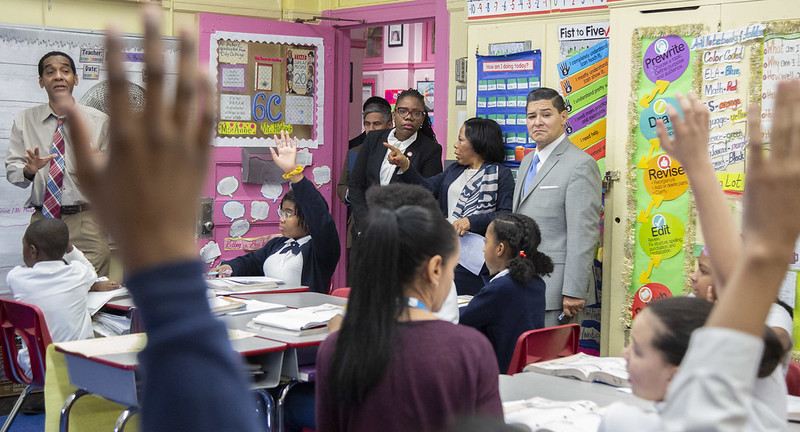
DOE Chancellor Richard Carranza visits a classroom (photo: John McCarten/City Council)
In the Campaign for Fiscal Equity case, the state’s Court of Appeals concluded in 2003 that class sizes were too large in New York City schools to provide our students with their constitutional right to a sound basic education, writing that “[T]ens of thousands of students are placed in overcrowded classrooms… The number of children in these straits is large enough to represent a systemic failure.”
And yet despite this decision, and the fact that when Bill de Blasio promised that, if elected mayor, he would lower class sizes in all grades to far lower levels, class sizes have stagnated during his time in office and remain on average 15-30 percent larger than in the rest of the state. In the early grades, they are substantially larger (by 10 percent) than in 2003 when that CFE decision was issued. More than 325,000 students are in classes of 30 or more this year. Let that number sink in.
The research on the benefits of class size is clear, especially for children in the early grades. Project STAR, a large-scale experiment carried out in Tennessee in the 1980s, showed that those students who were randomly placed in smaller classes in K-3 did better in every single way that could be measured. They earned better grades, better test scores, and were less likely to be held back and less likely to have disciplinary problems.
After they reached high school, they were more likely to graduate on time, head for college and graduate with a STEM degree, and own their own home more than 20 years later.
Though no large-scale experiment of a similar kind has been done on class size in the middle and upper grades, there are many studies that show a strong correlation between smaller classes in these grades and students earning better test scores, exhibiting improved non-cognitive skills, and having higher graduation rates, while controlling for other observable factors.
Most importantly, all these gains that result from smaller classes are twice as large for disadvantaged students and students of color, who make up the majority of kids in the New York City public schools. That is why class size reduction is one of only a handful of reforms proven to narrow the achievement and opportunity gap.
Since Mayor de Blasio took office, test score levels have been flat or declining, as measured on the national exams called the NAEPs, the most reliable assessments. And the gap in results between students of different economic and racial groups has widened.
None of this is particularly surprising of course.
In smaller classes, all students, but especially those who are struggling, have their academic and social-emotional needs better met, are able to receive more feedback from their teachers, and feel like their teachers care about them more. This motivates them to show effort and stay on track. It is the personal, human connection that inspires them to learn.
What’s sad is how many New York City teachers say they don’t even have time to answer all their students’ questions because their classes are too large. As a result, too many students are confused and lose interest, become passive and disengaged, or act out in order to obtain the attention they crave.
This is why New York City teachers overwhelmingly say that class size reduction would be the best way to improve our schools, and why New York City parents put smaller classes among their top priorities every year on Department of Education surveys. Most principals agree – and believe that to be able to provide a quality education, class sizes should be no more than 20 students per class in grades K-3, 23 in grades 4-5, and 24 in all other grades.
Schools Chancellor Richard Carranza is the first DOE Chancellor in many years who, when asked, admits that he realizes how important class size is. As a teacher, he says, he knew that he could reach his students better in a class of 24 than 30. And yet when questioned by the City Council at hearings or by parents at town hall meetings what he intends to do about it, his response is almost exactly the same as previous chancellors who had little or no interest in reducing class size: He will wait until the state provides more Foundation Aid funding and then he will allow principals do what they want with the extra funding. This is not an acceptable answer. Why?
First, New York City students should not have to wait for the state to fully fund Foundation Aid, when hundreds of millions of dollars are being spent by the Department of Education on less effective, unproven programs and other expenses — including a substantial increase in bureaucracy and more standardized testing — and the city continues to enjoy a surplus.
Second, the “Fair Student Funding” system, into which the additional Foundation Aid would flow, incentivizes principals to keep class sizes as large as possible, because their funding is tied to the number of students they enroll.
Lastly, class size reduction won’t happen in any systematic and rational fashion unless the New York City Department of Education has a plan to make it happen, by providing the staff and the space where it’s most needed, as they did when they expanded pre-kindergarten programs.
That’s why we are calling on the Mayor and the City Council to step up to the plate, and allocate $100 million in next year’s budget to be allocated specifically towards class size reduction, starting first in the early grades and in struggling schools.
This amount represents less than .3 percent of DOE’s total budget of $34 billion. It would represent the first step in a necessary process of beginning to provide New York City children with the truly equitable and excellent education they deserve, and which parents and educators have long known is badly needed for our schools to succeed.
***
Leonie Haimson is the Executive Director of Class Size Matters. On Twitter @leoniehaimson.
***
Have an op-ed idea or submission for Gotham Gazette? Email This email address is being protected from spambots. You need JavaScript enabled to view it.
Let's Legalize Surrogacy In New York The Right Way
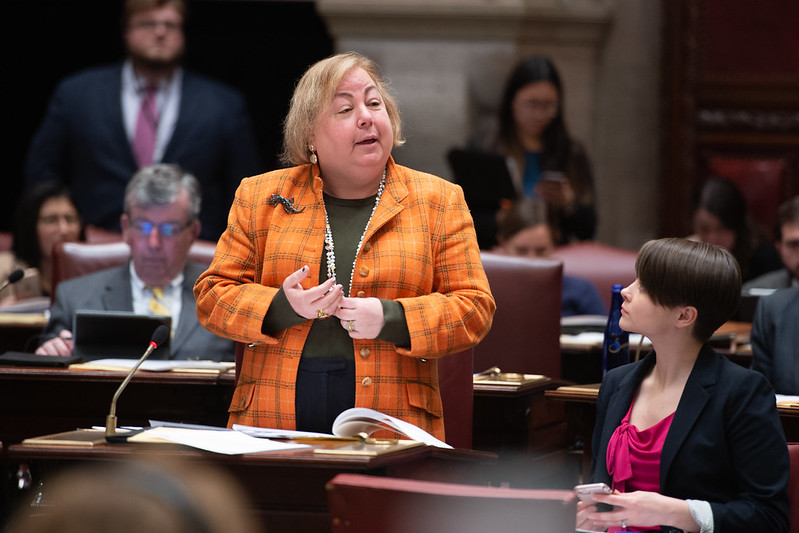
State Senator Liz Krueger, the author (photo: NY Senate)
Advances in assisted reproductive technology (ART), including intrauterine insemination (IUI), in vitro fertilization (IVF), egg and sperm donation, and surrogacy, have created remarkable new family-building options in the last several decades. As someone who is unable to have my own biological children, I support New Yorkers being able to use ART, including surrogacy, to build the families they want.
Yet these relatively new technologies bring with them complex issues that must be considered carefully. After many discussions with my colleagues who support existing proposals to legalize and regulate paid surrogacy in New York, as well as experts and advocates, I believe those proposals do not do enough to balance and protect the health, safety, interests, and rights of all parties involved.
At the same time, in spite of the fact that paid gestational and genetic surrogacy are currently illegal, the ART, gamete donation, and surrogacy industries are already operating in New York, with insufficient regulation and protections. That is why I have introduced an alternative bill, along with Assemblymembers Didi Barrett and Danny O’Donnell, to tighten regulations on gamete donation and to legalize surrogacy with appropriate safeguards.
Our bill goes further than existing proposals in creating consumer protections, ensuring that participants are fully informed of health risks and other relevant factors, preventing exploitation, power imbalances, and inequitable treatment, requiring the use of best medical practices to protect the health and wellbeing of all parties, and information-gathering to facilitate much-needed research and tracking.
Intended parents, people acting as surrogates, egg and sperm donors, and of course any children that are conceived by assisted reproduction or born through surrogacy, are all intimately invested in the process and outcomes of any gamete donation or surrogacy agreement. For intended parents who decide to use surrogacy, they spend a significant amount of money, take time to carefully choose a person who will bear their child, and place their hopes in the person acting as surrogate.
Surrogates take on significant risks to their health, and in some cases their lives. They place their trust in the intended parents to adhere to the surrogacy agreement, and to provide a good home for the children they have spent nine months growing and nurturing inside their own body.
Children born through surrogacy or using ART have a right to have their needs and interests considered throughout the process, and to access data and research that are sorely lacking today on the health impacts of using certain forms of ART.
Our bill strengthens the existing proposals through several new or tightened provisions, including:
Evaluating intended parents and people acting as surrogates to assess eligibility.
Minimizing health risks for surrogate by establishing age restrictions, requirements relating to prior pregnancies and births, and preclusions on preexisting medical and psychological conditions that would make the pregnancy high-risk.
In order to prevent human trafficking, requiring intended parents and surrogates to be U.S. citizens or permanent lawful residents, and New York State residents for at least 12 months prior to executing an agreement.
Explicitly requiring more comprehensive, longer-lasting health, life, and disability insurance be provided to the surrogate.
Recognizing and protecting the human agency of the surrogate by allowing them to terminate the agreement at any time during the pregnancy. If this happens, the surrogate must return any financial compensation already received other than payment for medical, legal, and pregnancy-related expenses.
Creating a window after the birth of a child during which, in rare and extreme circumstances, the person acting as surrogate could ask a court to step in and determine legal parentage.
I believe that these measures, and several others addressing not only surrogacy but an array of assisted reproduction technologies, are necessary to balance the needs and interests of all the people engaged in gamete donation or surrogacy agreements. I hope that my colleagues in the Legislature, and Governor Cuomo, will take the time – after the new state budget is passed – to thoroughly consider and discuss all of the options on the table. Fundamental issues of equity, family, health, and people’s lives are at stake.
***
State Senator Liz Krueger is a Democrat representing parts of Manhattan. On Twitter @LizKrueger.
***
Have an op-ed idea or submission for Gotham Gazette? Email This email address is being protected from spambots. You need JavaScript enabled to view it.
Attorney General Disrupts Progress on Taxi Loan Crisis
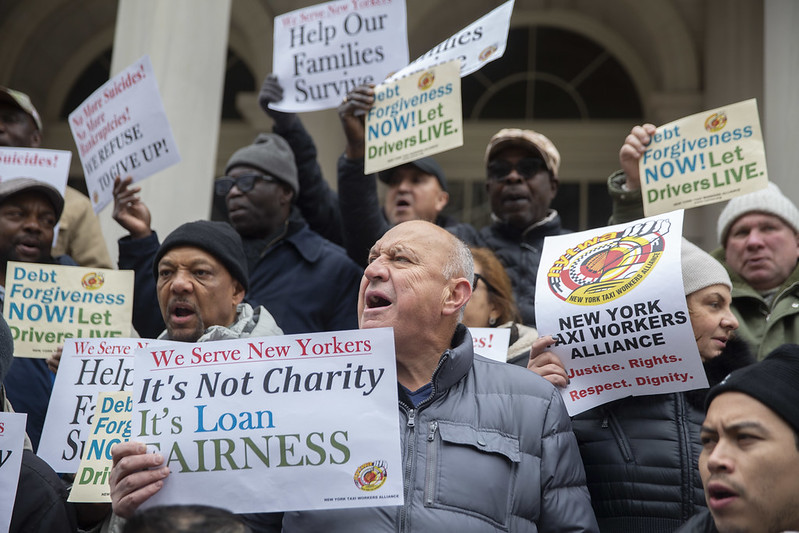
Taxi driver-owners protest at City Hall (photo: John McCarten/City Council)
Last May I wrote a column criticizing the practice of including taxi medallion sales revenue in the city’s operating budget and pointed out the perverse incentive it creates to encourage high sales prices. My comments were triggered by the publication of a compelling investigative series on the New York City taxi medallion market in the New York Times.
The series provoked outrage from elected officials, several of whom launched investigations and studies of their own. The City Council appointed a task force, which recently came up with thoughtful recommendations; but the state’s attorney general has thrown a wrench into efforts to responsibly help needy taxi medallion owners by threatening to sue the city to give all their money back to everyone who bought medallions during the ten-year period when prices rose and then fell so dramatically.
It is heartbreaking to hear the stories of taxi drivers, many of them immigrants, who thought that ownership of a taxi medallion was a ticket to the American dream, only to see their value plummet as an onslaught of ride-hailing vehicles flooded city streets. But the challenge is how to help these driver-owners in a way that is appropriate and fiscally responsible.
In the early 2000s when the city’s economy was doing well and the ceiling on the number of medallions made them a scarce resource, it made sense that they were extremely valuable. Yes, the New York City Taxi and Limousine Commission (and city’s budget office, which counted on medallion sales revenue to help balance the budget) encouraged -- or at best, did not try to mitigate – the rapid growth in medallion prices from 2004-2014, but market conditions were the primary cause.
In retrospect it looks crazy that prices rose as high as they did, but no one wanted to cast a skeptical eye (except Citizens Budget Commission and other fiscal monitors, of course) on a business that could empower hard-working people to prosper. No one anticipated the rapid and dramatic creation and growth of Uber, Lyft, and other ride-hailing services that have overwhelmed city streets with cars and left taxi drivers scrambling for passengers and income.
After the Times series the City Council created a Taxi Medallion Task Force that issued its report last month, recommending that the city form an entity to purchase outstanding medallion loans at discounted prices and work with borrowers to pay them back over time. The report recognizes that it is not feasible for the city itself to fully buy the loans, although it states that costly city-sponsored loan insurance might be necessary to make the fund viable. What is proposed is a kind of public-private partnership in which “mission-driven” entities such as socially responsible investors and philanthropies contribute to a pool of funds. While Mayor de Blasio has not endorsed this specific recommendation he has said this is the best solution he has heard to the problem so far.
However, before there has been any time for this approach to be refined and pursued, along comes New York Attorney General Letitia James with a plan that would be more straightforward and far more costly to execute: sue the city and make it pay back all the $800 million-plus it has collected for medallion sales since 2004. A notice has been filed with the City Comptroller giving the city 30 days to resolve the claim before a lawsuit is filed.
The threat of this litigation casts a pall over other attempts to help underwater taxi medallion owners by getting their lenders to accept discounted amounts. Why would anyone agree to take less money when there is now the prospect that the city will pay the full amount borrowed? Why would financial institutions and other lenders participate in the City Council’s plan to create a fund for this purpose if the need is obviated by the AG’s lawsuit?
While AG James is undoubtedly trying to help struggling individual driver-owners, it is primarily professional industry lenders and fleet owners who would benefit from her claim. And it would unfairly hold New York City government responsible for a problem that has multiple layers and causes.
Most important, the AG’s litigation would set an extremely dangerous and expensive precedent that taxpayer dollars can and should be used to bail out an entire line of business that has hit hard times. (It is unclear how the lawsuit would impact negotiations to reduce the amount due on several thousand medallion loans just purchased from the National Credit Union Administration by a hedge fund, Marblegate Capital.)
Can the city be expected to pay off the loans of restaurateurs who must close because of new minimum wage and other regulatory requirements? What about the mortgages of homeowners who may face more difficulty paying them off if and when property tax reforms are adopted? By the way, when the Attorney General was a City Council member she voted to approve the budgets that included the revenue from medallion sales; does that make her culpable too?
The city has no choice but to resist the AG’s attempt to be the taxi industry hero at everyone else’s expense and the City Council should join the mayor in denouncing the lawsuit.
Meanwhile, even if the city successfully facilitates a loan fund, still left unresolved is how to keep medallions financially viable over the long-term. What is needed is a coherent plan of reforms and new policies to make the system of taxis and for-hire vehicles in New York City functional going forward.
***
Carol Kellermann was president of Citizens Budget Commission from 2008 through 2018.
***
Have an op-ed idea or submission for Gotham Gazette? Email This email address is being protected from spambots. You need JavaScript enabled to view it.
With Marijuana Back on the Agenda, It's Time New York Lawmakers Get Serious About Social Equity
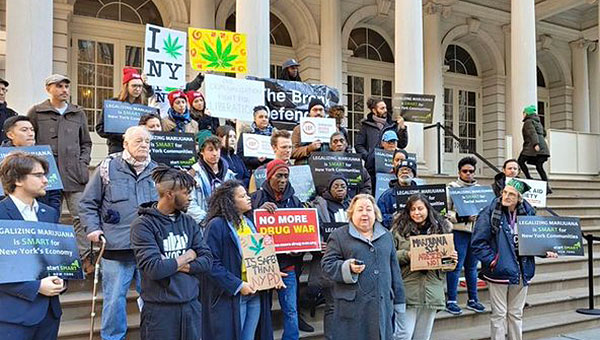
Rally to call for legalization of adult marijuana use (photo: @equityorg)
Governor Cuomo's rollout of a reworked Cannabis Regulation and Taxation Act means this may finally be the year New Yorkers get access to legal weed. And while a similar legalization push floundered in the statehouse last year, many are optimistic about its odds during the 2020 legislative session. Not only are the vast majority of New Yorkers in favor of adult-use sales, but legislators staring down the barrel of a $6 billion budget hole will be hard-pressed to turn down an estimated $300 million in annual tax revenue.
As for the New York lawmakers who haven't yet succumbed to the siren song of legal marijuana? Their colleagues may soon force their hand. Massachusetts currently allows for adult-use sales — and Connecticut, Rhode Island, and New Jersey are all aggressively eyeing legalization. Cuomo has even helped convene neighboring leaders to coordinate a regional approach to the effort. If the other states' proposals pass, New York will be forced to choose whether to follow their lead or risk watching those potential tax dollars pad the budgets of neighboring states — plenty of New Yorkers are already heading to Massachusetts to get legal cannabis.
Still, legalization is far from a done deal. Like last year, we're sure to see a showdown between Cuomo and the Legislature when it comes to the issue of 'social equity.' Many Democractic lawmakers want a guarantee that a percentage of New York's cannabis tax revenues will help fund programs and policies that serve the communities hit hardest by decades of marijuana arrests. Cuomo would prefer to put the money in the state's general fund, where he can distribute it as he sees fit.
As recent news reminds us, the past half-century of cannabis criminalization has had devastating consequences in low-income communities of color, in New York City and others around the state. And while legal marijuana may be minting a new class of cannabis industry millionaires, the spoils of the "Green Rush" are almost exclusively flowing to a small group of wealthy, well-connected, and disproportionately white players. This is unacceptable in any industry, but it's particularly infuriating given the fact the low-income, rural, and/or minority communities being shut out of the sector are the same people who've borne the brunt of our prohibitionist policies in the first place.
So yes, I agree with many of the Legislature's leaders — it's only right we use some of this revenue to repair the harms of the War on Drugs. That said, if the Legislature doesn't act more strategically, we'll end up wasting this unique opportunity to create a diverse, equitable, and sustainable new industry in New York State.
Social equity funding may be the biggest difference between the dueling marijuana legalization efforts, but that disagreement pales in comparison to the macro-problems found in both proposals. Our legislators would be smart to look into the issues that have plagued other states post-legalization.
Despite having an extensive cultivation network, a glut of pro-legalization politicians, and the country's largest population of cannabis consumers, California is seeing its legal marijuana market implode. Prohibitively high taxes and exceptionally burdensome regulations have driven prices so high that patients and consumers are left with no choice but to buy products from unlicensed sources. As a result, experts estimate 85-90% of California's cannabis sales are made in the unregulated market. This shift has bankrupted smaller marijunana outfits and forced larger cannabis companies to constrict and consolidate. If California's problems continue to go unaddressed, they could very well work to increase organized crime's influence in the industry.
It's difficult to shed a tear when you learn about the troubles of shady operators like MedMen. That said, both Cuomo's Cannabis Regulation and Taxation Act and the Legislature's Marijuana Regulation and Taxation Act create a taxation and regulatory structure that would make it nearly impossible for even the most well-capitalized cannabis corporation to survive, let alone a small, rural, and/or minority-owned business.
We can't forget that a non-functional legal sector means no money for social equity initiatives. If we want these programs to thrive, we'd be wise to look to the regulatory environment in cannabis markets like Colorado — a place where the state's $2 billion in annual cannabis tax revenue can actually help fund social services. To his credit, Cuomo recently announced he'll be heading to other legal states to learn more about what strategies have and haven't worked in their marijuana markets.
Another knock on New York's legalization bills? The lack of nuance. Even if the Legislature manages to secure social equity funding, what's its plan for steering that money into the communities it's meant to serve? Given state-run programs are floundering across the country, the how is an increasingly important — and often underlooked — question.
Why are so many social equity initiatives struggling? One reason is the fact they focus (almost exclusively) on creating licensing processes that prioritize businesses run by individuals that have been disproportionately impacted by cannabis prohibition. Facilitating entrepreneurship in rural and minority communities is a laudable goal, no doubt, but even if those programs help businesses navigate the byzantine patchwork of local and state regulations, they don't help them access the capital (a couple million dollars, at least) required to get a cannabis company up and running.
For argument's sake, let's just say New York's social equity-focused licensing program—as written—is successful (an outcome that's eluded other legal states). The bill mainly focuses on prioritized business licenses—a critical issue of course, but still an effort that would impact a relatively small number of people. While I recognize legislators are looking for their ribbon-cutting moment, wouldn't it also be smart to put as much effort into building wealth via workforce development programs? Or create a more concrete plan for reinvesting tax revenues directly into underserved communities?
Given the sordid history and devastating consequences of marijuna prohibition, it's clear New York has a once-in-a-lifetime opportunity—as well as a moral imperative—to create a diverse, equitable and sustainable legal cannabis industry. At the same time, as we evaluate social equity initiatives across the country, it's also quite apparent we need to come up with smarter, more impactful ways to start "righting the wrongs of the War on Drugs."
***
Natalie Papillion is the Founder and CEO of The Equity Organization, a nonprofit focused on creating a diverse and equitable legal cannabis industry. On Twitter @npapillion & @Equityorg.
***
Have an op-ed idea or submission for Gotham Gazette? Email This email address is being protected from spambots. You need JavaScript enabled to view it.
Health Care Reform New York Should Tackle Now: A Rational Payment System
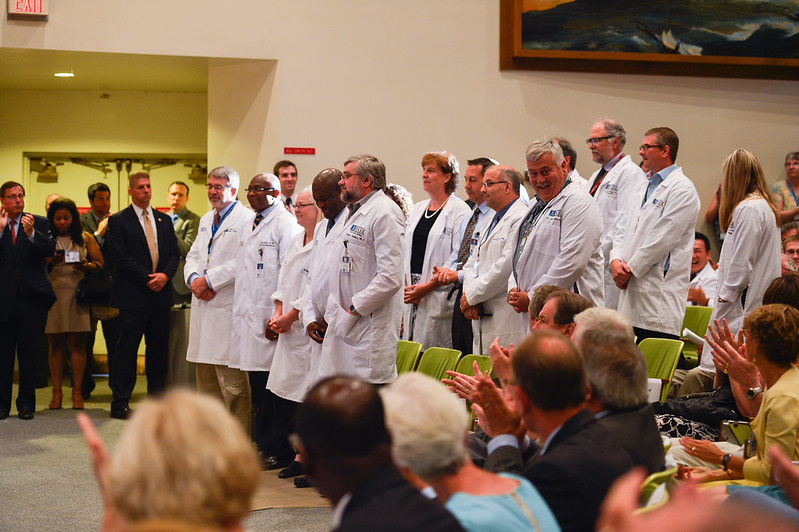
(photo: Governor's Office)
A New Yorker who suffers a heart attack is typically rushed to the nearest hospital for treatment. In a life-threatening emergency minutes matter, so the practice is sound public policy. Yet, if it turns out the hospital is not in the patient’s insurance network, the sigh of relief is short-lived. The bill for the care can top $100,000. Surprise!
Unaffordable medical bills are the top financial concern of two-thirds of Americans. The crazy system we have created of public and private health insurers, in-and-out of network providers, and hospitals and doctors who can charge any amount they please but do not have to disclose their prices publicly, leads to outcomes that are outrageously unfair on a regular basis, particularly for urgent care.
Since access to healthcare is a fundamental human need, an effective federal government would create a national system based on rational principles. Sadly, the United States Congress has been unable to achieve this goal, something every other advanced country in the world has accomplished. Two committees in the current House of Representatives session are considering surprise medical bill legislation, but there is no way to know if those efforts will yield results. New York should not wait and leave its people subject to the whims of Washington’s partisan political wars.
The New York State Assembly has twice passed the New York Health Act, a proposal to create a statewide single-payer system to replace the current structure. The New York State Senate, however, has not approved the legislation that would eliminate private insurance altogether in favor of a Medicare-like government program that would cover all New Yorkers. If New York were starting fresh, that might be a sensible way forward. But we are not. Millions of New Yorkers rely on employer-sponsored, private-insurer health plans and do not want to be forced off of them. Improving the quality and accessibility of health care in New York must take that reality into account.
Decision-makers must also recognize that hundreds of thousands of New Yorkers’ jobs and livelihoods are linked to the existing structure. Change must take place at a pace the public will support.
A better alternative is the creation of a state agency to set the amount any hospital or doctor can charge for a service and require all insurers to reimburse care providers the same amount. It is the type of system Maryland implemented long ago and that was recently adopted in Washington State.
A rational system that establishes a uniform fee appropriate for each service would replace the current one, which allows every provider to create its own price list. Fees would be transparent and consistent. It would put an end to today’s practice where providers charge different insurance companies different fees for identical services depending on the insurer’s bargaining power and network status.
Today’s system, in addition to creating unaffordable surprise bills, leads to cruel irony. Uninsured and underinsured individuals often end up being charged the highest price, while someone with a good job and good benefits at a large company is likely covered by an insurer who pays a far lower amount. The diabolically unfair logic of the system is part of the reason medical expenses are the single largest cause of bankruptcy filings in the United States, which is unconscionable.
The rational system proposed would allow the state to exert influence on medical costs to prevent them from going up faster than wages and people’s ability to pay them. An annual statewide cap on price increases allowed across the system would prevent unsustainable rises in medical costs while allowing necessary adjustments and pricing flexibility for new innovations without limiting increases caused by growth in healthcare use.
To ease the transition such a change would require, New York State should phase in the rational payment system starting with private insurance plans for hospital procedures. Over time, the program can be expanded to merge the reimbursement rates for public and private insurance plans, and similar structures can be set-up for doctors and pharmacies.
The proposed system would make New York’s healthcare payment system rational, and more affordable. That would be a surprise people would welcome.
***
Chris McNickle writes about New York government and politics. His most recent book is Bloomberg: A Billionaire’s Ambition. On Twitter @NYChrisMcNickle.
***
Have an op-ed idea or submission for Gotham Gazette? Email This email address is being protected from spambots. You need JavaScript enabled to view it.
Cruising is a City Problem Bigger Than For-Hire Vehicles, Deserving a Complete Policy Response
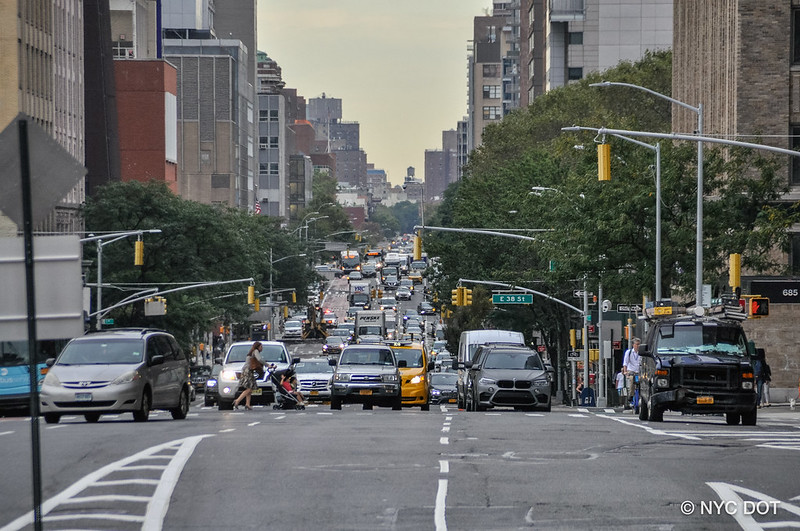
Traffic, mobility, for-hire vehicles & others need a solution (photo: NYC DOT)
Earlier this month, news broke that the New York City Council is considering new regulations on transportation network company (TNC) vehicles cruising city streets in search of passengers, with hopes that the move would ease Manhattan congestion. The measure would mirror the city’s recently-passed congestion fee, which similarly blames for-hire vehicles for clogging city streets with cars.
Like the congestion fee, this proposal is an incomplete policy mechanism that is unlikely to noticeably improve the urban problem it’s designed to alleviate. And like the congestion fee, it could set a bad example for municipalities elsewhere who seek to mimic New York’s policy decisions.
Automotive traffic congestion is a major societal problem. Its human cost is measured in jobs lost because of buses that never seem to run on time, daycare late fees straining family budgets, and dinners reheated in the microwave. Traffic also slows commerce, with truckloads of e-commerce parcels and industry inputs sitting in the same roadway backlogs as drivers and passengers. In short, state and local governments are working to improve traffic conditions every day for good reason.
One primary cause of traffic is “cruising” behavior — the act of driving around searching for someone or something on the street. The oft-repeated statistic from leading parking professor Donald Shoup is that about 30 percent of urban traffic consists of cruising, although the observed range can vary significantly among cities.
The New York for-hire vehicle proposal would target one form of cruising by one subset of road users in its effort to improve traffic congestion. TNC drivers certainly drive around alone, waiting for a fare to cause their phones to ping. But they’re not alone; many other people are doing a version of the same thing.
Taxis cruise around in search of hailing pedestrians on the streets. Food delivery drivers look for somewhere to idle while they pick up orders. And most commonly of all, individual drivers in personal vehicles wander the streets, intent on finding an empty parking spot beside a city-owned curb. Any political change that seeks to address traffic caused by cruising must reckon with the fact that cruising is a ubiquitous driving behavior that’s carried out by almost all drivers, not just those that move others around for a fee.
But that would be a far more challenging change to implement than shunting the burden onto a fraction of drivers. While this fraction spends a lot of time on the road, non-TNC drivers still make up the majority of traffic, and dealing with cruising by this majority would do far more for congestion than regulating TNC drivers alone.
Of course, it’s a lot harder to directly police cruising behavior by non-TNC drivers. Overcoming associated privacy concerns is one challenge that’s held back sensible transportation changes, like implementing a vehicle-miles-traveled fee in lieu of gasoline taxes. Ensuring that every driver has working tracking technology can quickly become a mess, as federal laws mandating electronic trucker hours record-keeping have recently shown.
If direct, widespread limits on cruising aren’t politically viable or technologically reliable, it may be better to view cruising as more of a symptom of poor transportation policy decisions than a disease in and of itself — and to treat the underlying causes instead. As professor Shoup has explained for decades, misaligned parking and road prices are what encourage wasteful traffic behaviors that include cruising.
Policymakers who want to get at the root cause of this issue are better off shifting their energies toward the political lift of raising the price of street parking to ensure spaces regularly change hands. Higher rates should be universal across the city such that residents who drive can expect to pay everywhere, preventing the incentive to cruise for free parking before it happens.
Unwinding parking subsidies remains a challenging political issue, but one that stands to improve urban traffic wherever changes are made. Unfortunately, New York’s cruising reform proposal misses this entirely. One would hope traffic-reforming politicians in the city and elsewhere will opt for a more complete policy response.
***
Nick Zaiac is a resident fellow in transportation and infrastructure at the R Street Institute. On Twitter @NickZaiac & @RSI.
***
Have an op-ed idea or submission for Gotham Gazette? Email This email address is being protected from spambots. You need JavaScript enabled to view it.
A Renewed Appreciation for Freedom, and for Serving My Community

Alec Brook-Krasny (photo: @AlecBrookKrasny)
Twenty years ago, when I first ran for office, I was not like most other candidates. Democracy was not something I was born into. Instead, I left the country where I grew up and traveled across the world to trade the oppression of the Soviet Union for the freedom of the United States. As a result, when I asked my neighbors to elect me to the New York State Assembly, it was because I wanted to give back to the community and country that had welcomed me with open arms and helped me to achieve the American Dream.
Twenty years later, as I now announce my candidacy for the New York City Council, I am still not like most other candidates. But what sets me apart is not just that I had to fight to find freedom. Now, what sets me apart is that I have had to fight to hold onto my freedom.
In 2017, I was falsely accused of crimes I did not commit.
It was easy, at first, to feel lost. Overwhelmed. Even defeated. After years of dedicating myself to the community and public service, my life had become synonymous with a lie. No matter how strongly I maintained my innocence, no matter how much evidence my lawyers and I turned over showing that I had done nothing wrong, it seemed like everyone else, especially the prosecutors, refused to listen.
But once the shock wore off, and the reality of the situation sunk in, I knew I had to stand my ground. Innocence must not compromise. Baseless as the charges against me were, I knew that once a jury heard my case—once my peers sat in judgment—the facts would carry the day.
Three years since, after being fully exonerated, I feel lucky. Not lucky to have won—I always believed that the truth would succeed—but lucky to have been in a position to win. Lucky that I found great lawyers—lawyers who never wavered in defending me and never suggested I plead guilty to crimes I did not commit. Lucky that I had resources—mounting a defense costs huge amounts of time and money, and for me, even when I ran out of money, my lawyers still stuck by me, so great was their belief in my case. Lucky that I had support—friends, family, my community, and many more all stood strongly behind me.
Most of all, I am lucky to have been the exception, not the rule.
Countless others will never have the chance to properly defend themselves. Without access to top lawyers, without resources, without a support system, anyone can fall through the cracks. For those people, the overlooked, ignored, forgotten, I will fight. I will ensure that our justice system provides the necessary tools to help people not need luck. Laws like the expanded right to counsel, discovery reform, eliminating cash bail, and increased funding for alternatives to incarceration are all positive steps towards a justice system that is equal and bent toward compassion for all it serves.
Twenty years ago, when I first ran for office, I asked my neighbors to give me the privilege of representing them. During my time in the Assembly, we achieved so much. We increased financial support for public schools, Coney Island Hospital, and subsidized housing. We enacted anti-violence programs that made our communities safer, especially for seniors. And we worked together to recover, rebuild, and revitalize after Superstorm Sandy. After all that, leaving the Assembly was one of the hardest decisions I ever made, but it was the only way for me to provide for my family.
Today, however, I am forced to ask myself: what good is providing for your family if our institutions fail to protect them? Whether by rebuilding our criminal justice system or fixing public transportation, lifting up struggling schools or supporting workers and small businesses, I am running for City Council to answer that question head-on. I am ready to stand for Bensonhurst, Coney Island, Gravesend, Sea Gate, and beyond, to make sure that the future is as bright for our children as it ought to be.
***
Alec Brook-Krasny is a former Assemblymember and candidate for City Council in the 47th District. On Twitter @AlecBrookKrasny.
***
Have an op-ed idea or submission for Gotham Gazette? Email This email address is being protected from spambots. You need JavaScript enabled to view it.
New York Needs to Invest in the Catskills for the Good of the Whole State

The Catskills from above (photo: @CatskillCenter)
Albany’s budget is tough this year, with an unprecedented $6.1 billion gap to close. New York State has adopted the nation’s most ambitious climate change agenda, which will cost $33 billion over five years, and Governor Cuomo proposes keeping the State’s Environmental Protection Fund (EPF) at a record $300 million.
Environmental spending may seem like a luxury when budgets are tight, let alone unprecedented environmental spending. But doubling down on the state’s environmental agenda is the responsible choice—not a luxury.
This year’s EPF appropriations as outlined in the governor’s budget plan will fund climate change programs ($20 million), solid waste programs ($39 million), open space ($152 million), and parks and recreation ($89 million). It funds mitigating and adapting to climate change, stimulating renewable energy, protecting farmland, fighting invasive species, improving water quality, supporting tourism growth, and seeking environmental justice. These smart investments in our future also generate statewide economic development, sustainable growth, and fiscal returns.
State funding has helped ramp up Catskills tourism to 12 million visitors a year and counting (currently more than the Adirondacks and roughly twice the visitorship of the Grand Canyon). Last year Lonely Planet named the Catskills one of the Top 10 Best Regions for Travel.
Even with New York’s other world-class industries, as the state's third-largest employer, tourism is key. In the Catskills, tourism generates $1.3 billion a year in direct spending, $161 million in state and local taxes, and supports 18,500 jobs. These numbers are growing fast, with an 11.3% jump in 2019 Catskills tourism over 2018.
The Catskills are a unique part of the world: pristine forests, abundant wildlife, vital waterways, unique communities, and unparalleled recreational opportunities—all within an easy drive to New York City, which gets most of its drinking water, some of the nation's purest, from Catskills reservoirs.
Catskills public lands are managed both by the state Department of Environmental Conservation (DEC) and New York City’s Department of Environmental Protection, and receive no Parks Department funding. Like the rest of the world, our resources are threatened by climate change, development pressures, and other factors. Continued tourism growth, thriving communities, and environmental protection depend on state investment in the region.
Every year I help lead a coalition of several dozen local groups and volunteers to Albany for Catskill Park Day, where we make the case to state legislators and the governor’s office for directing funding to the Catskills. In 2015 we obtained $500,000 in the DEC’s “Aid to Localities” budget, which paid for new trails, access improvements, and parking areas. In 2016 the Assembly's budget included $4 million for the Catskills in the EPF, but it was zeroed out in the final budget negotiations. The next year, we secured over $15 million in state funding.
This year, we asked Governor Cuomo to increase the overall EPF and allocate $15 million in his budget to manage and grow Catskills tourism through infrastructure improvements, fund the Catskill Visitor Center, install renewables in the region, conduct local research on invasives and Lyme disease, and support economic development of Catskills towns.
Although the governor understands the need to invest in the region, and included some of the coalition's requests in his executive budget for next fiscal year (FY2021), this legislative session will be the acid test of whether this kind of spending can survive the budget process.
Some will ask if we can afford to invest in the Catskills given the $6.1 billion gap. But the region is a key environmental resource, an integral part of the fight against climate change, an engine of tourism and upstate economic growth, and contributes to what makes New York unique. The question ought to be, can we afford not to?
***
Jeff Senterman is the Executive Director of the Catskill Center. On Twitter @JeffSenterman & @CatskillCenter.
***
Have an op-ed idea or submission for Gotham Gazette? Email This email address is being protected from spambots. You need JavaScript enabled to view it.
To Protect New Yorkers’ Health, New Patient Protection Laws Must be Enforced

(photo: Governor's Office)
When it comes to determining the proper course of care for a serious health issue, decisions should be made by a patient and their health care provider. But too often, health insurers have been undermining providers’ decisions in efforts to cut costs — forcing them to navigate burdensome bureaucratic roadblocks before agreeing to cover prescribed treatments and services. That can result in patients facing delays in care or going untreated altogether.
To address this problem, New York lawmakers recently worked to protect patients by requiring health plans to ensure timely access to care. Unfortunately, new findings suggest that these new requirements are frequently not being met, and it should be the priority of patients, health care providers, and advocates throughout New York to ensure that these new laws are being enforced.
With health care costs continuing to spiral, many health insurers have explored ways to rein in spending. Policies such as prior authorization, which requires health care providers to receive approval from an insurer before prescribing a costly treatment or service, or step therapy, which requires patients to try and fail on alternative, typically older medications before moving on to newer and sometimes costlier treatments, have become widely integrated among health insurance plans in recent years.
However, these policies often end up creating unnecessary burdens by delaying treatment and undermining what practitioners deem to be the most effective course of care. Providers have long complained that prior authorization requests can often take anywhere from a few hours to a few weeks to be approved — or worse yet, denied — leaving patients without necessary care during this lengthy and frustrating process.
In fact, a 2018 survey from the American Medical Association found more than one in four physicians reported that these cumbersome requirements “led to a serious adverse event” for patients under their care.
New York lawmakers took action in recent years to strengthen patient protections, passing a pair of bills that would increase efficiency with prior authorization and grant more timely exceptions to step therapy requests. For example, under the new laws, health insurers must now respond to prior authorization requests in 72 hours for routine care and 24 for urgent situations. Similarly, patients can receive an exception to step therapy protocols if the plan’s required treatment is expected to be ineffective or the patient already tried and failed on the required treatment.
But many providers have come forward to express concerns that health insurers are not abiding by these new requirements. According to a recent survey of New York providers, for example, just 30 percent say that health plans are meeting these approval request times “every time,” and 33 percent say that the paperwork process has not been simplified or see no difference.
Meanwhile, more than 79 percent of providers say that the changes in step therapy laws either have made the process to request an exception more difficult or have not made a difference. Worse, given their frustrations, many providers do not seek to appeal the denial and instead will simply prescribe another medication — which may not be as effective as the originally prescribed treatment.
While health plans are still adjusting to these new regulations, these findings suggest there is significant room for improvement when it comes to increasing access to care. Physicians and patients should go through the appeals process to petition insurers for their treatments and file complaints for egregious behavior. At the same time, lawmakers and regulatory agencies can take a more proactive approach to ensuring that these policies are being enforced appropriately, including collecting data from insurers to measure compliance.
The passage of these bills was a landmark moment for patients, providers, and advocates throughout New York in guaranteeing better access to health care. Now, they must make their voices heard to state lawmakers and regulators in order to ensure that they are able to realize the promise that these bills once held.
***
Stacey Worthy is a staff attorney for Aimed Alliance, a non-profit health policy organization that seeks to protect and enhance the rights of health care consumers and providers.
***
Have an op-ed idea or submission for Gotham Gazette? Email This email address is being protected from spambots. You need JavaScript enabled to view it.




